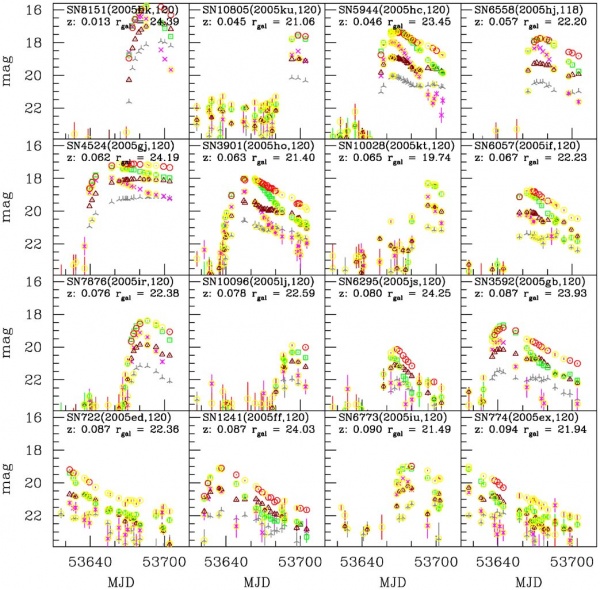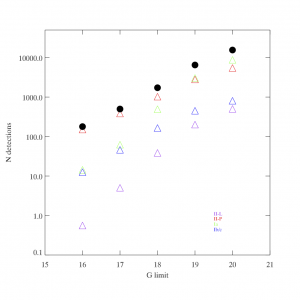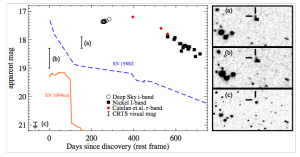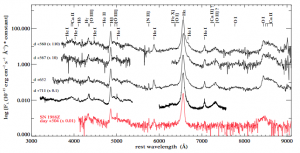Triggers:Supernovae
Supernova Types and Rates
Numbers based on Belokurov and Evans (2003: MNRAS, 341, 569-576). Note that f in the table below is the fraction of all type-II supernovae that are L-type (they suggest using f=0.5). The numbers are derived by taking the Galaxy number counts out to 75 Mpc and extrapolating as D^3. These are combined with supernova event rates compiled from the literature.
Although Belokurov and Evans used an old scanning law to make their predictions, the numbers of total events down to G=20 will not change.
This magnitude limit corresponds to a distance of 630 Mpc for a type-Ia with an average G-band maximum magnitude of -18.99.
| Type | Total to G=20 |
|---|---|
| Ia | 48000 |
| Ib | 7000 |
| IIL | 28500*f |
| IIP | 5600*(1-f) |
The other piece of information needed is the Luminosity function. Supernova absolute magnitude distributions are also given in Belokurov and Evans. They assume Gaussian distributions of absolute magnitude around maximum brightness as below:
| Type | <math>M_{G}</math> | <math>\sigma_G</math> |
|---|---|---|
| 1a | -18.99 | 0.76 |
| 1b/c | -17.75 | 1.29 |
| II-L | -17.63 | 0.88 |
| II-P | -16.44 | 1.23 |
Peter Nugent's page with templates for SNe [1]
Revised numbers can be found here: [2]. The bottom line is that the total SuperNova catch is more like 19 down to G=19 (2000 before maximum), and about 200 will be brighter than G=16. A figure is reproduced here.
Supernovae type Ia
SDSS-II Supernova Survey (Stripe 82)
Stripe 82 spreads over 300 sq.deg between RA=-60 to RA=60 and Dec=-1.25 to Dec=+1.25. It was monitored by SDSS in 5 filters (ugriz) since 1998, but more intensively in 2005 and 2006. Numerous supernovae were found in 2005 season using difference imaging techniques, e.g. Sako et al. 2008.
 From Holtzman et al. 2008.
From Holtzman et al. 2008.
Rise and fall times of SN Ia
Hayden et al.2010 studied times of rise and fall of supernovae Ia. They selected a subset of 105 light curves well-observed in both rise and fall portions of the light curves and developed a '2-stretch' fit algorithm which estimates the rise and fall times independently. They found the average time from explosion to B-band peak brightness is 17.38 +/- 0.17 days, but with a spread of rise times which range from 13 days to 23 days. This average rise time is shorter than the 19.5 days found in previous studies.
Supernovae type II
Example of unusual supernova IIn 2008iy Miller et al. 2009., which took 400 days to rise.
For the progenitors of the type IIn the best candidates are Luminous Blue Variables (LBV) Dwarkadas (2010).
Luminous Red Novae
The class of Luminous Red Novae was established in 2007 by Shrinivas Kulkarni classifying M85 OT2006-1 as LRN. It is disputed if it is a new class or subclass of SN-IIp.
- they are fainter than SNe and brighter than novae.
- they last over several weeks.
- distinctively red in colour, getting redder while fading
Extremely Luminous Supernovae
Type IIn, <math>M_V \approx 22.1~\textrm{mag}</math>, example: 2008fz detected by the Catalina Survey Drake et al. 2009
Underluminous Supernovae
Possibly linked with double-degenerate binary systems containing extremely low mass (<0.25 Msol) white dwarfs Brown et al.(2010).


